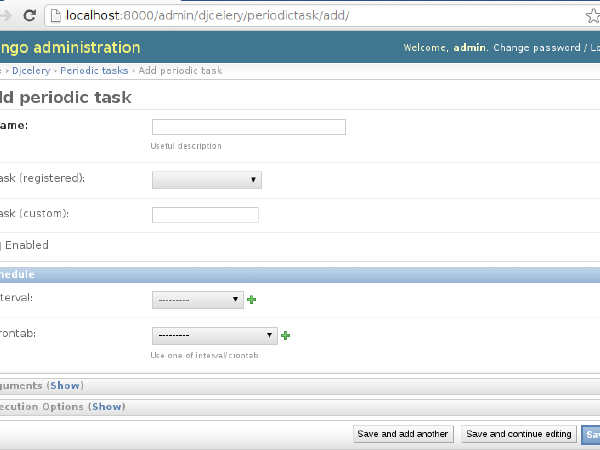How-To
2014

Getting Started Scheduling Tasks with Celery
UPDATE: A newer version of this blog post is available for Celery Version 5.0.x.
Getting Started Using Celery for Scheduling Tasks
Many Django applications can make good use of being able to schedule work, either periodically or just not blocking the request thread.

Managing Events with Explicit Time Zones
Managing Events with Explicit Time Zones
Recently we wanted a way to let users create real-life events which could occur in any time zone that the user desired. By default, Django interprets any date/time that the user enters as being in the user’s time zone, but it never displays that time zone, and it converts the time zone to UTC before storing it, so there is no record of what time zone the user initially chose. This is fine for most purposes, but if you want to specifically give the user the ability to choose different time zones for different events, this won’t work.
2013

Using strace to Debug Stuck Celery Tasks

Skipping Test DB Creation
We are always looking for ways to make our tests run faster. That means
writing tests which don't preform I/O (DB reads/writes, disk
reads/writes) when possible. Django has a collection of TestCase
subclasses
for different use cases. The common TestCase handles the fixture
loading and the creation the of TestClient. It uses the database
transactions to ensure that the database state is reset for every test.
That is it wraps each test in a transaction and rolls it back once the
test is over. Any transaction management inside the test becomes a
no-op. Since [TestCase]{.title-ref}[ overrides the transaction
facilities, if you need to test the transactional behavior of a piece of
code you can instead use
]{.title-ref}[TransactionTestCase]{.title-ref}[.
]{.title-ref}[TransactionTestCase]{.title-ref}` resets the database
after the test runs by truncating all tables which is much slower than
rolling back the transaction particularly if you have a large number of
tables.

Central logging in Django with Graylog2 and graypy
Django's logging configuration facilities, which arrived in version 1.3, have greatly eased (and standardized) the process of configuring logging for Django projects. When building complex and interactive web applications at Caktus, we've found that detailed (and properly configured!) logs are key to successful and efficient debugging. Another step in that process — which can be particularly useful in environments where you have multiple web servers — is setting up a centralized logging server to receive all your logs and make them available through an easily accessible web interface. There are a number useful tools to do this, but one we've found that works quite well is Graylog2. Installing and configuring Graylog2 is outside the scope of this post, but there are plenty of tutorials on how to do so accessible through your search engine of choice.

Migrating to a Custom User Model in Django
UPDATE: Read a newer blog post on this topic.
The new custom user model
configuration
that arrived in Django makes it relatively straightforward to swap in
your own model for the Django user model. In most cases, Django's
built-in User model works just fine, but there are times when certain
limitations (such as the length of the email
field)
require a custom user model to be installed. If you're starting out
with a custom user model, setup and configuration are relatively
straightforward, but if you need to migrate an existing legacy project
(e.g., one that started out in Django 1.4 or earlier), there are a few
gotchas that you might run into. We did this recently for one of our
larger, long-term client projects at Caktus, and here's an outline of
how we'd recommend tackling this issue:

MEDIA_ROOT and Django Tests
If you’ve ever written a test for a view or model with associated
uploaded files you might have noticed a small problem with those files
hanging around after the tests are complete. Since version 1.3, Django
won’t delete the files associated with your model instances when they
are deleted. Some work-arounds for this
issue
involve writing a custom delete for your model or using a post_delete
signal handler. But even with those in place the files would not be
deleted during tests because the model instances are not explicitly
deleted at the end of the test case. Instead, Django simply rolls back
the transaction and the delete method is never called nor are the
signals fired. This can be quite an annoyance when running the tests
repeatedly and watching your MEDIA_ROOT (or worse your S3 bucket) fill
up with garbage data. More than annoyance, this introduces something you
always want to avoid in unittests: global state.


Managing Django Translations with Transifex
We manage a number of open source Django apps here at Caktus. While many of us here are proficient in a number of programming languages, the same can’t be said for our ability to read or write in languages other than English. The Django community is global and we want our apps to support other languages. For that we’ve turned to Transifex which it the same tool Django itself uses for translations.

A helper script for runserver
My Django runserver shortcut script
This is a little shell script I save as rs, put on my path, and use as
a shortcut to start the Django development server. It has several
features that make me more productive: